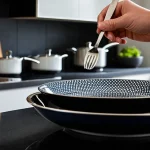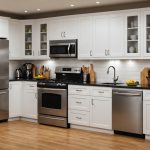Immediate Impact of Open-Plan Kitchens on UK Home Life
Open-plan kitchens UK have reshaped the fabric of family home design, creating more fluid and connected living spaces. This layout influences UK home lifestyle trends by encouraging shared activities, such as cooking and dining, which were once isolated in separate rooms. Families now experience more interaction during daily routines, fostering togetherness and enhancing communication.
The open-plan design changes home life dynamics by breaking down physical barriers, allowing parents to supervise children while preparing meals. It also promotes multitasking, as individuals can blend food preparation with socializing or helping with homework. These shifts lead to a more versatile use of space, aligning with contemporary UK home lifestyle trends focused on functionality and social engagement.
Also to see : How are UK homeowners incorporating sustainable practices in kitchen renovations?
In UK residential architecture, open-plan kitchens reflect a broader trend favoring natural light, spaciousness, and ergonomic flow. This design prioritizes both aesthetics and practicality, mirroring evolving lifestyles that value openness and connectivity. The result is a home environment where interaction and convenience coexist, underscoring the ongoing evolution of family home design in the UK.
Social Connection and Entertaining in Open-Plan Kitchens
Open-plan kitchens have revolutionised social interaction within UK homes by seamlessly blending cooking, dining, and living areas. This design fosters an inclusive atmosphere where hosts can engage with guests while preparing meals, eliminating the isolation often found in closed kitchens. Families and friends now experience more fluid communication, enhancing the overall enjoyment of gatherings.
Additional reading : How Is the Future of British Kitchens Shaping Up?
Hosting guests in an open-plan space encourages a relaxed, communal vibe. Instead of segregated rooms, people can circulate freely, making conversations more dynamic and natural. This setup suits the evolving lifestyle of modern UK households, where entertaining at home has become more interactive and informal.
Moreover, these kitchens provide versatility for different entertaining styles, from casual family dinners to lively social events. The shared space encourages participation—someone might help with meal prep while others set up the dining area or mingle nearby. This shift reflects a broader cultural change in how people connect during social occasions, prioritising togetherness and spontaneous interaction.
For those considering a renovation, it’s worth noting how an open-plan design can transform everyday cooking into a shared, enjoyable experience, supporting stronger social bonds and more memorable moments.
Space Utilization and Home Functionality
Optimising space in modern UK homes is essential as living areas become more compact. Space optimisation focuses on using every inch effectively without compromising comfort. One of the most practical approaches is designing kitchens with a multi-functional design, combining cooking, dining, and socialising zones seamlessly.
Adaptability is key to meeting diverse household needs. For instance, incorporating flexible furniture and storage solutions allows spaces to transform effortlessly from workstations to relaxation areas. This flexibility suits families with children, remote workers, or those who love entertaining.
Incorporating workspaces, relaxation corners, and play areas within the kitchen enhances home functionality significantly. Imagine a kitchen island that doubles as a homework station, or seating that provides comfort for both meals and casual chats. Such integration supports a dynamic home environment, reducing clutter and promoting efficiency.
By prioritising UK homes space solutions that embrace adaptability and multi-functionality, homeowners can enjoy spaces that feel larger and more versatile. This thoughtful integration ultimately improves everyday living, fostering harmony between different activities in a limited footprint.
Expert Perspectives and UK-Specific Examples
Understanding expert insight from architects and industry professionals sheds light on the nuances of modern home design in the UK. Architects commonly debate the benefits and drawbacks of open-plan living, noting that while it fosters social interaction and natural light, it challenges privacy and noise control. They often recommend thoughtful zoning and versatile furniture to balance openness with individual space needs.
In UK case studies, many homeowners report that open-plan layouts suit family life, allowing parents to supervise children easily while preparing meals. However, some find adapting traditional homes to this style raises structural concerns or reduces storage—highlighting the importance of bespoke adaptations tailored to each property.
Home design analysis by industry experts also identifies long-term trends. The emphasis is shifting towards multi-functional spaces that accommodate remote work and leisure simultaneously. Innovations such as sliding partitions and smart technology enhance flexibility, reflecting changing lifestyles. These insights confirm that successful open-plan designs must align with occupants’ daily routines and personal preferences.
Collectively, expert perspectives and UK-specific examples underscore that while open-plan living holds many advantages, it requires careful planning and customization to address practical challenges effectively.
Benefits and Drawbacks of Open-Plan Kitchen Living
Open-plan kitchen living offers significant advantages such as enhanced natural light and a greater sense of space. By removing walls, light flows freely between areas, creating an inviting and airy environment. This openness is particularly valued by UK homeowners seeking a modern, communal atmosphere where cooking, dining, and relaxing blend seamlessly.
However, open-plan living is not without its challenges. Noise can easily travel from the kitchen to adjoining spaces, disrupting quiet activities and daily routines. Additionally, privacy may be compromised since the lack of partitions means less secluded areas for family members or guests. Another common issue relates to heating efficiency; large open spaces often lose warmth faster, which can result in higher energy costs during colder months.
UK homeowner experiences often reflect these trade-offs. Many appreciate the sociable and light-filled environment but note the practical difficulties, especially concerning noise and temperature control. For instance, busy households find it tricky to manage acoustics when multiple activities occur simultaneously. Despite these challenges, thoughtful layout planning and targeted solutions like zoning or acoustic materials can help mitigate downsides, making open-plan kitchen living a compelling but complex choice for many.
Influence on Family Dynamics and Daily Routines
Families often experience significant shifts in family routines when adapting to new circumstances. Increased supervision brings members closer, enhancing togetherness but also demanding more coordinated effort. This heightened presence can transform how meal preparation is shared, allowing more collaborative cooking but also introducing challenges in balancing workloads.
Homework time is another arena where routines change. Parents become more involved, guiding children through tasks and creating structured schedules. This involvement strengthens bonds but requires clear boundaries to prevent conflicts. Leisure activities also evolve; family members seek new ways to enjoy time together, adapting to available spaces and interests.
Shifting boundaries between work, study, and family life create a complex dynamic. For instance, remote work in the UK has intensified the melding of professional and personal spaces, prompting families to redefine roles and expectations to maintain harmony. Establishing dedicated work zones at home and respecting “quiet hours” helps manage these overlaps.
Such lifestyle changes in the UK underline the importance of communication and flexibility. Families who openly discuss their needs and routines tend to navigate these changes more successfully, cementing a balance between productivity and quality time.
Maintenance Tips for Robot Hoovers
Keeping your robot hoover in peak condition ensures it cleans efficiently and lasts longer. Regular maintenance is key to avoiding common performance issues. Start by emptying the dustbin after each use to prevent clogging that can reduce suction power. Check and clean the brushes weekly; hair and debris often get tangled, affecting the robot’s cleaning ability.
Filters require attention too. Washable filters should be rinsed every month, while non-washable ones need replacing every few months depending on usage. Failing to maintain filters can lead to poorer air quality and diminished suction. Sensor cleaning is essential for navigation. Use a soft, dry cloth to gently wipe sensors, ensuring your robot hoover doesn’t get stuck or miss spots.
If battery life seems short, calibrate it by letting it fully discharge and then recharge. Always use the manufacturer’s charger to extend battery life. Finally, keep the wheels free from hair or dust to maintain mobility on various floor types. Proper maintenance not only improves cleaning performance but also prolongs the lifespan of your robot hoover, allowing continued hassle-free cleaning.




